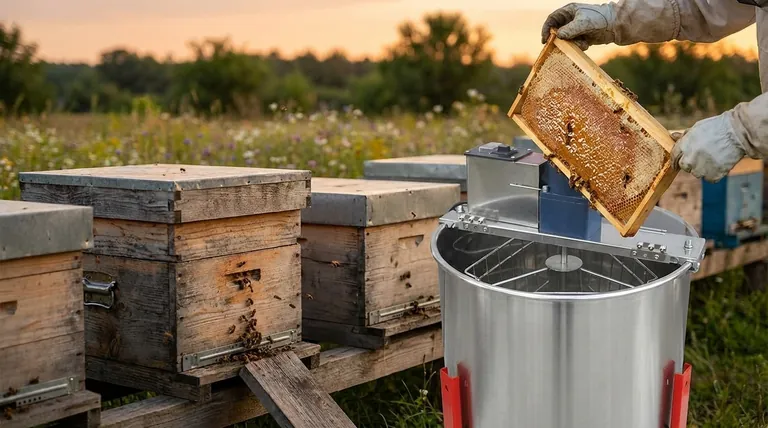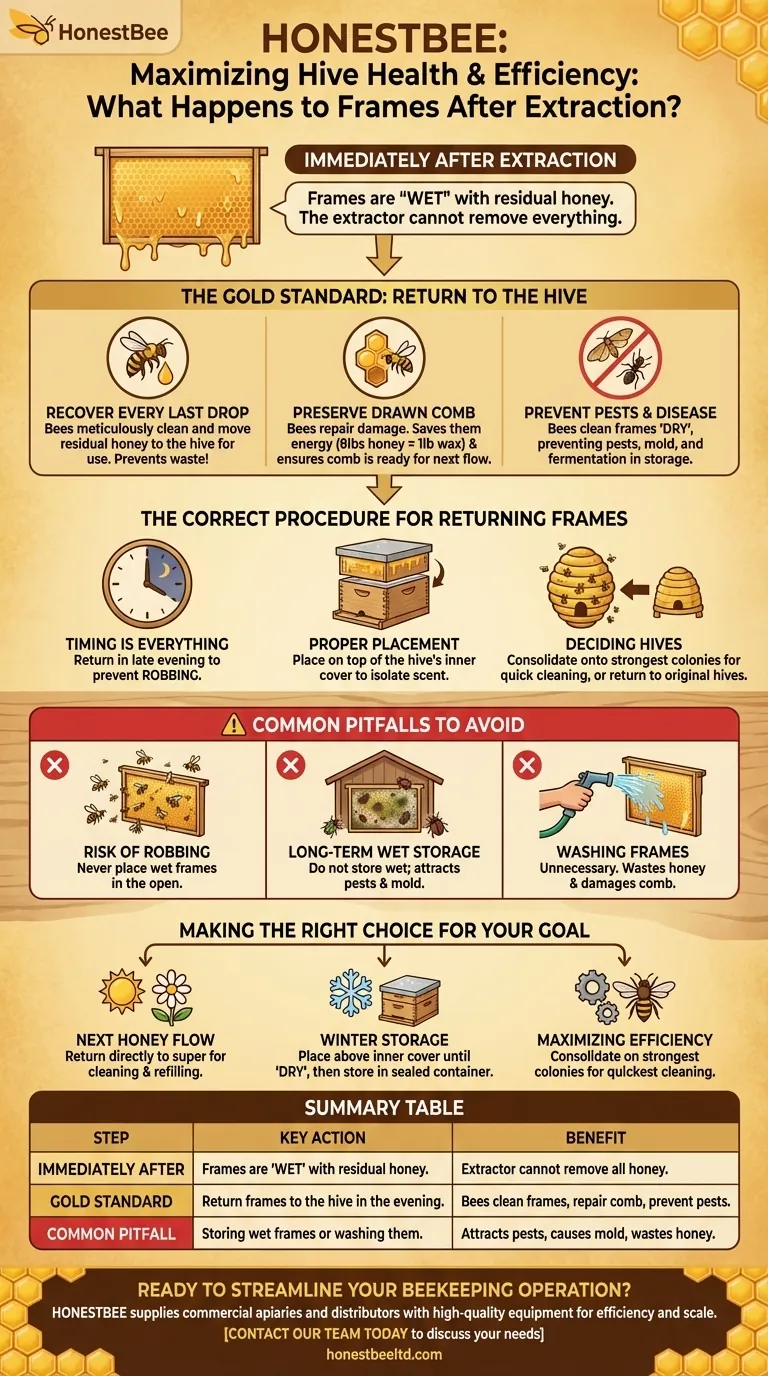Immediately after extraction, your honey frames will be "wet" with a residual film of honey that the extractor cannot remove. The standard and most beneficial practice is to return these frames to your hives for the bees to clean and repair, ensuring no honey goes to waste and preserving the valuable comb.
The primary goal of managing post-extraction frames is not just to recover the remaining honey, but to leverage the bees' natural behavior to preserve valuable drawn comb, prevent pest infestations, and prepare the frames for either immediate reuse or safe long-term storage.

Why Returning Wet Frames is the Gold Standard
Returning wet supers to the colony is a cornerstone of efficient and sustainable beekeeping. It taps into the bees' instincts to conserve resources and maintain their hive.
Recovering Every Last Drop
The bees are exceptionally efficient. They will meticulously clean every cell, moving the residual honey from the wet frames down into the hive for their own use. This prevents waste and provides the colony with a small but helpful nutritional boost.
Preserving a Critical Resource: Drawn Comb
Drawn-out beeswax comb is an incredibly valuable resource. It takes bees an enormous amount of energy and nectar (estimated at 8 pounds of honey to produce 1 pound of wax) to build. Returning the frames allows them to quickly repair any damage done during uncapping and extraction, ensuring this resource is ready for the next honey flow.
Preventing Pests and Disease
Storing sticky, wet frames in a shed or garage is an open invitation for pests like wax moths, ants, and small hive beetles. It can also lead to mold and fermentation. By letting the bees clean the frames "dry," you are preparing them for safe, pest-free storage.
The Correct Procedure for Returning Frames
How and when you return the frames is critical to avoiding problems, particularly robbing behavior between hives.
Timing is Everything: Preventing Robbing
The scent of exposed honey can trigger a "robbing frenzy," where bees from other colonies attack a hive to steal its resources. To prevent this, return wet frames in the late evening, just before dusk. At this time, most foragers are back in their own hives, drastically reducing the risk of instigating robbing.
Proper Placement in the Hive
The safest method is to place the wet super on top of the hive's inner cover. This allows the resident bees to access the frames through the inner cover's hole, clean them out, and carry the honey down. It isolates the honey scent and makes it difficult for outside bees to gain access.
Deciding Which Hives Get the Frames
You can return the supers to the hives they originally came from. Alternatively, many beekeepers consolidate all wet supers onto their strongest, most populous colonies. These hives have the workforce to clean the frames quickly and efficiently, often within a day or two.
Common Pitfalls to Avoid
Improperly managing wet frames can cause more harm than good. Understanding the risks is key to protecting your colonies.
The Critical Risk of Robbing
Never place wet frames out in the open for bees to "clean up." This is the number one cause of robbing events, which can weaken or even destroy entire colonies. Always return frames directly to a hive in the evening.
The Problem with Long-Term Wet Storage
If you cannot return the frames to the bees immediately, do not simply store them wet. They will quickly attract pests and begin to mold. The honey can ferment, ruining the comb for future use. The only viable storage is "dry" storage after the bees have cleaned them.
Washing Frames: An Unnecessary Step
Some new beekeepers are tempted to wash the residual honey off the frames with water. This is counterproductive. It wastes honey, can damage the delicate wax comb, and leaves the frames damp and prone to mold. The bees are far better equipped for the job.
Making the Right Choice for Your Goal
Your next step depends on the time of year and your immediate objective for the frames.
- If your primary focus is preparing for the next honey flow: Return the wet frames directly to the super boxes so the bees can clean, repair, and immediately begin refilling them.
- If your primary focus is preparing frames for winter storage: Place the wet super above the inner cover for a few days until the bees have cleaned it completely "dry," then remove and store it in a sealed container or bag.
- If your primary focus is maximizing hive efficiency: Consolidate all your wet frames onto your strongest colonies for the quickest and most thorough cleaning before storage or reuse.
By properly managing your frames post-extraction, you support the long-term health of your colonies and set yourself up for future success.
Summary Table:
| Step | Key Action | Benefit |
|---|---|---|
| Immediately After | Frames are 'wet' with residual honey. | Extractor cannot remove all honey. |
| Gold Standard | Return frames to the hive in the evening. | Bees clean frames, repair comb, prevent pests. |
| Common Pitfall | Storing wet frames or washing them. | Attracts pests, causes mold, wastes honey. |
Ready to streamline your beekeeping operation?
Proper frame management is just one part of a successful apiary. HONESTBEE supplies commercial apiaries and beekeeping equipment distributors with the high-quality, durable supplies needed for efficiency and scale. From extractors to storage solutions, our wholesale-focused operations are designed to support your business.
Contact our team today to discuss your equipment needs and how we can help your operation thrive.
Visual Guide

Related Products
- electric honey extractor honey centrifuge 3 frame honey extractor stainless steel honey frame extractor
- 2 Frame Stainless Steel Manual Honey Spinner Extractor for Beekeeping
- Commercial Electric 12 Frame Honey Extractor Spinner Motorized Honey Extractor
- HONESTBEE 72 Frame Industrial Electric Honey Extractor for Beekeeping
- 24 Frame Honey Extractor Commercial Radial Honey Frame Extraction Machine
People Also Ask
- What is a honey extractor and why is it beneficial for beekeepers? Boost Hive Health & Harvest Efficiency
- What is the basic principle of the honey extractor? Harness Centrifugal Force for Efficient Harvesting
- What are the steps for honey extraction using a centrifuge? A Guide to Efficient, Comb-Preserving Harvests
- How do automatic honey extractors function? Achieve High-Efficiency Honey Harvesting
- What are the two main types of honey extractors? Choose Between Tangential and Radial for Your Apiary



















